-
How Customer Journey Mapping Tools Improve Website Content
-
#1. The HubSpot Buyer Persona Tool
-
#2. The Customer-Centric Business Model Canvas
-
#3. Jobs To Be Done Template
-
#4. The Customer Journey Map
-
#5. The Buyer Journey Template
-
#6. Key Page Flows
-
#7. SlickPlan (Site Maps)
-
The Key To Effective Website Content

7 Customer Journey Mapping Tools That Will Revolutionize Your Website Content
To many companies, website content is merely an accessory to design. It fills in the blanks behind pretty illustrations, flashy calls-to-actions, and sophisticated parallax functionality.
How Customer Journey Mapping Tools Improve Website Content
Your website content is critical to generating conversions. When you have a clear, cohesive message on your site, visitors engage faster and move through your site with ease. It cuts down on the mental calories they need to spend to figure out what you do, why you do it, and how it helps them.
Because at the end of the day, customers don’t care. They want to solve their problems and move on. If you can identify those challenges, you can craft customer-centric content that provides answers to those challenges. This is where customer journey mapping tools and resources can be extremely useful.
#1. The HubSpot Buyer Persona Tool
Who is your ideal customer? What do they care about? What are their goals?
If you don't know, you'll operate off assumptions to make critical content, inbound marketing, sales, and website decisions. For you, this translates to a lot of budget spent on educated guesses. But you can avoid this by developing in-depth buyer personas to represent 2-3 ideal customers.
There are a lot of buyer persona templates out there, but none of them are as engaging as HubSpot’s buyer persona tool. The tool is easy to use and asks the right questions to develop and document your personas.
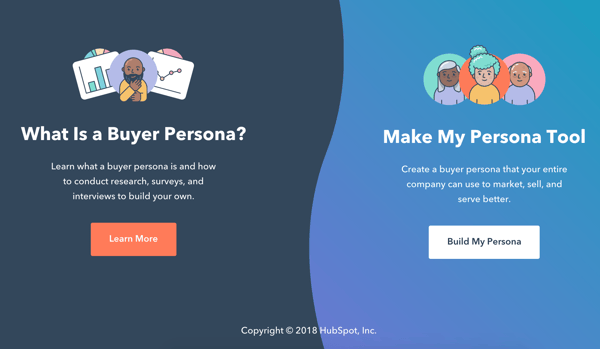
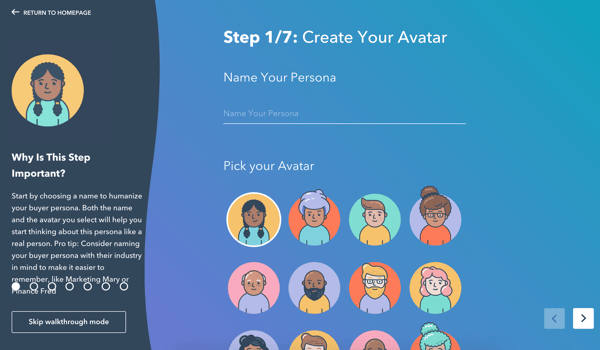
Using the personal tool, you can flesh out your personas with customer interviews, email surveys, market research, and more.
#2. The Customer-Centric Business Model Canvas
Seth Godin, marketing guru, and author introduces a really powerful metaphor in his book, This Is Marketing, that about a lock and a key.
The idea is that you wouldn’t design a key without having a lock designed first. It wouldn’t make any sense. And it’s the same as your ideal customer's problem. Without an idea of what the customer's problem is (the lock) why would you think you had the key (the solution?)
That's why you want to get the customer problem right from the beginning.
.png?width=600&name=canvas%20(1).png)
The customer-centric business model canvas can help you gain better awareness into what your customer’s primary problems, points of friction, and triggers actually are, rather than what you believe they are. You can use these insights to write more compelling website content.
#3. Jobs To Be Done Template
There are always quick and easy ways to solve a problem. Without any real urgency, your customer doesn't have to act. They don't need to solve their problem yet. That's why smart marketers leverage social and emotional "jobs" in website messaging to pull leads through the funnel.
-1.png?width=600&name=jobstobedone%20(2)-1.png)
With the jobs to be done template, you can assess the situation your customer is currently in, what their motivation is, the outcome of that change, how that outcome will make them feel, and the social job that will fulfill, or how others will perceive them. loading=lazy
#4. The Customer Journey Map
The customer journey map is one of my favorite tools for building website content. You get all of the details about what your persona is doing to resolve their challenges from start-to-finish.
.png?width=600&name=customerjourneymaptemplate%20(1).png)
You use the customer journey map to capture the persona's experience and document it on one page. Then, you create another map and document what the customer’s ideal experience would be.
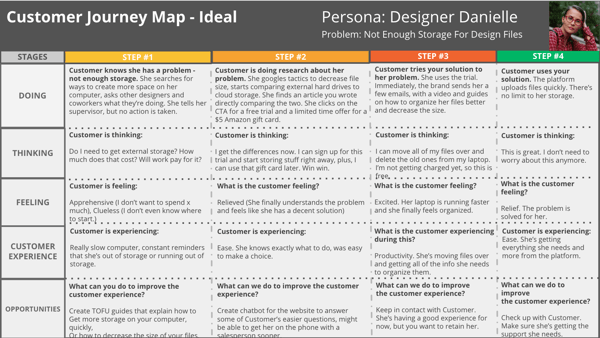
The customer journey map template gives you everything you need to get an accurate picture of what your customer experiences. When you’re humble and honest, you can get a lot of great insights from this exercise. loading=lazy
#5. The Buyer Journey Template
To build an effective website, you need to get the buyer journey right. If you don’t know what they’re thinking or feeling in the awareness, interest, desire, consideration, or decision stages, you won’t develop the type of content or message you need to engage them effectively.
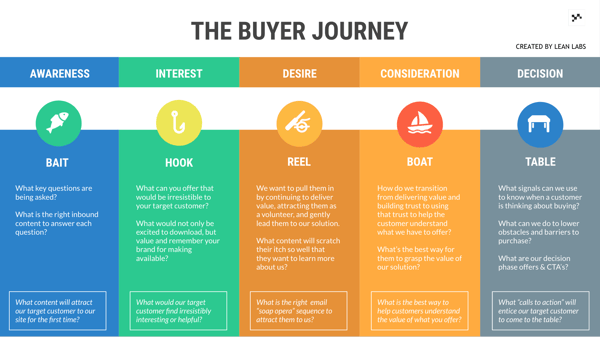
A buyer journey template helps you document the exact content and messaging you need to create for every stage:
Awareness
At the awareness stage, you need the material that will grab your ideal persona’s attention for the very first time. It can be an Ebook, workbook, or podcast that you will make a landing page for, link to from blog posts, etc.
Interest
Interest stage content will attract your ideal customers. The website content will be more specific and make it clear who this offer or lead magnet is for, and who it isn't. At this stage, dig into the details of your buyer persona and their demographics, as well as the characteristics of a qualified lead.
Desire
Website content that supports this stage should communicate that you’re extremely capable of solving the lead's problem. You can do this through white papers or webinars, anything that helps them trust you along with messaging that shows your value without coming out and saying it for yourself.
Consideration
Website content for the consideration stage will help the customer grasp why you’re the right match for them. Offers can include case studies, before and after pieces, or customer testimonials. Website messaging should show results, such as statistics, proof points, quotes, and other unbiased, third-party information.
Decision
Website content for the decision stage will help lower your customer’s barriers and remove any obstacles to purchase. At this part of the buyer journey template, you may want to go back and refer to the Customer-Centric Business Model Canvas and identify all of the reasons your customer would not buy from you.
When you’re done filling the buyer journey template out, you can use the takeaways to kickstart the website pages and content you’ll need to build.
#6. Key Page Flows
Key page flows are useful for outlining website page content. If you’re using the rest of the customer journey mapping tools to inform your website content strategy, filling out your page flows will be a snap.
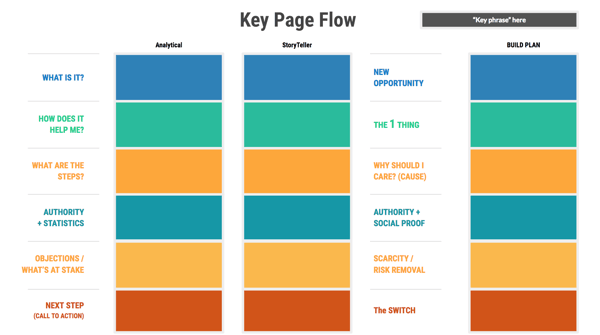
You’ll start at the top and move to the bottom, answering questions such as:
From your customer’s perspective, what is your product or solution? (Think specifically about what problem it solves for them when you answer this.)
What new opportunity does it provide to your ideal customer?
How does it help your customer grow and change?
What is the one thing that your customer needs to hear about what your product or service does?
What are the steps involved in working with you?
Why should the customer care about it?
What authority, statistics, or social proof can you provide to reinforce your product or service?
What will happen if the customer does not get it?
What can you provide to the customer that will make them feel like they’re not taking a risk?
How do they take action?
What needs to happen to make the customer switch from a competitor to you?
There’s a lot to go through there, but if you answer every question honestly, you will have a rough draft of your page. You can edit and polish copy as needed, then take that page flow and prototype out your page.
#7. SlickPlan (Site Maps)
A big part of planning website content is figuring out the flow of the website. Every page needs to lead to a next logical step. With a list of the website and landing pages you need to create, start mapping out how they connect.
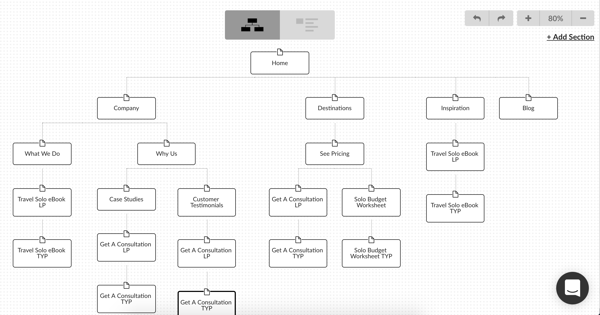
I use SlickPlan to build the structure, called a sitemap. You can also sketch this out on a whiteboard or with a pen and paper.
Start from your homepage and work your way out. A visitor lands on your homepage. Where should they go next?
If they’re a new lead, they’ll go toward your TOFU (top-of-the-funnel) offer. If they’re an existing customer, they will go to the login page.
Think of it as an airport. Some visitors will have a few connections to reach their destination, while some know exactly where they are going, and require the quickest route to arrive.
When you finish, you can use SlickPlan to show how the pages will branch out and link together. It will be a critical tool for planning your customer’s journey through your website and will ensure that nothing feels awkward, cumbersome, or out of place as they go.
The Key To Effective Website Content
When your website content doesn't resonate with your ideal customer, you're fighting an uphill battle. You'll alienate qualified visitors, or you will attract the wrong customer completely. Either way, you won't get the results you need to grow, and you'll burn through your marketing budget trying to get there. That's why effective website content requires a lot of customer research and strategy.
Our Strategy Kit includes the customer journey mapping tools I mentioned above, as well as additional resources. You can use our brand voice exercises, sitemap tips, key page flows, and buyer journey templates to create a consistent website narrative and a clear path for leads to follow.
Download the Strategy Kit for free and use it again and again to create exceptional website content that delivers results.





